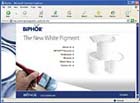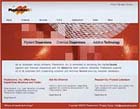ACCUPLACE: Updated Website
This company's updated website enables engineers and manufacturing and operations managers to learn about problem analysis and solution without facing problems firsthand. Sorted by market segment or automation grades, the site provides more than 50 case studies on the assembly of adhesive-backed components. The library covers the Mobile Communications, Automotive, Computer & Peripherals and Medical & Industrial markets, as well as various grades of automation and integration into production lines.Web: www.accuplace.com

BUNGE: White Pigment Website
This company has announced the launch of its new website dedicated to BIPHOR™ white pigment, www.biphorpigments.com. Now, formulators of paints, coatings and allied products can log on for a ready introduction to the revolutionary product that provides greater performance value than standard titanium dioxide (TiO2), the most expensive ingredient in today's paint and coating formulations. Using a menu included on each page, visitors will be able to easily navigate anywhere on the site to find what they need, including general information and technical data, production details, market information, product updates, and trade share alerts. Technical papers, product comparison studies and specification sheets are all available in pdf format.Web: www.biphorpigments.com
GREYSTONE MATERIAL TECHNOLOGIES: Market Report
Adhesives are critical components in the design and manufacture of the majority of medical devices. As medical devices become smaller and more complex, greater demands are being made on the materials and components used in them. As the adhesives industry responds to the challenges of the market, new advances are widening the performance envelope for medical adhesives. Variations in polymer composition, coupled with compounding differences, are allowing properties to be tailored to meet specific application requirements, including biostability, sterilization effects and mechanical properties. These developments and the opportunities they represent are detailed in Medical Device Adhesives: Markets and Opportunities, a comprehensive market report written to be of maximum value to adhesive manufacturers and marketers. It consists of in-depth analyses, descriptions and evaluations of current and probable future market developments, technology issues and business factors - all of the information necessary to compete effectively in this evolving market.Web: www.tech-assessment.org
MACTAC: Online Performance Guides
To help educate OEMs and converters on the applications, physical properties, chemical resistances and shelf lives of MACtac's pressure-sensitive adhesive tapes, this company has made its product performance guides available online. These guides detail each PSA tape's adhesive, carrier, liner, thickness and temperature range. They also contain information on typical performance data, including results from quick tack, peel adhesion and shear tests. The performance guides can be used to obtain a general idea of standard product performance, as well as application examples. Customers are encouraged to consult a MACtac sales representative to ensure that the right PSA tape is selected for an application. If a PSA tape does not meet a manufacturer's requirements, the company will work closely with customers to develop a PSA tape that will.
Web: www.MACtac.com
Phone: (800) 328-2619
E-mail: MACtactechnical@bemis.com

PLASTICOLORS INC.: Updated Website
Plasticolors Inc. recently announced the launch of a renovated website offering readers a colorful, in-depth look at how the company utilizes the latest advancements in color and dispersion science to provide optimum solutions for each customer. The new site offers an "Ask the Chemist" option, wherein technical representatives from Plasticolors respond to visitors' questions. The site also features a special research and development area highlighting the company's color science and analytical capability, along with unique areas of interest that include UV protection and conductive and thickener technology. A glossary of industry terms and a variety of white papers are also featured on the site.
Web: www.plasticolors.com
Phone: (440) 997-5137
SMTA: Online Resource
The information presented in the newly established resource on smta.org for Environmental Compliance & Lead-Free Technology includes an event listing, related links, and technical resources the SMTA offers, such as technical articles in the Knowledge Base and reference books available in the Bookstore. The event listing features SMTA activities at the local, national and international level that focus on environmental compliance and lead-free technology, or that have a significant portion dedicated to the topic. The related links include further information on legislation for the RoHS/WEEE/EU Directive, industry organizations similar to SMTA involved in environmental compliance and lead-free technology, and prominent industry company websites.
Web: www.smta.org
Phone: (952) 920-7682
E-mail: joann@smta.org
SARTOMER: Elastomer Compounders Booklet
This company has announced the release of Elastomer Cure Concepts, Volume IX, a 20-page technical booklet written for elastomer compounders. ElastomerCure Concepts provides compounders with the data necessary to improve the processing and performance of their elastomer systems using Sartomer's specialty rubber additives and other specialty chemicals. Topics featured in the booklet include: Improving Properties of HXNBR/HNBR Blends with Coagents; Improved Activation of Sulfur Vulcanization; The Versatility of (Meth)acrylates in Peroxide-Cured Thermoplastic Elastomer Vulcanizates; and more.
Web: www.sartomer.com
Phone: (800) SARTOMER
UV PROCESS SUPPLY: Dyne Testing Manual
A critical step in successful printing is matching the substrate surface tension to an ink or coating's surface energy. While many users are familiar with the concept of performing dyne testing to determine substrate surface tension, there is a prevailing confusion over how, why and when to dyne test. Proper Dyne Testing: How, Why and When to Perform describes different dyne testing methods and specifies those that are best suited for different applications. A handy "Suggested Treat Level" chart guides users to the recommended dyne levels for their materials. There is a step-by-step explanation that details proper testing procedure. Contact angle measurement, an alternative to traditional dyne liquid testing, is also explored, and an informative discussion on corona and other surface-tension-altering methods is presented, along with information regarding surface treatment for three-dimensional objects.
Web: www.uvprocess.com/manuals
Phone: (800) 621-1296
E-mail: info@uvps.com